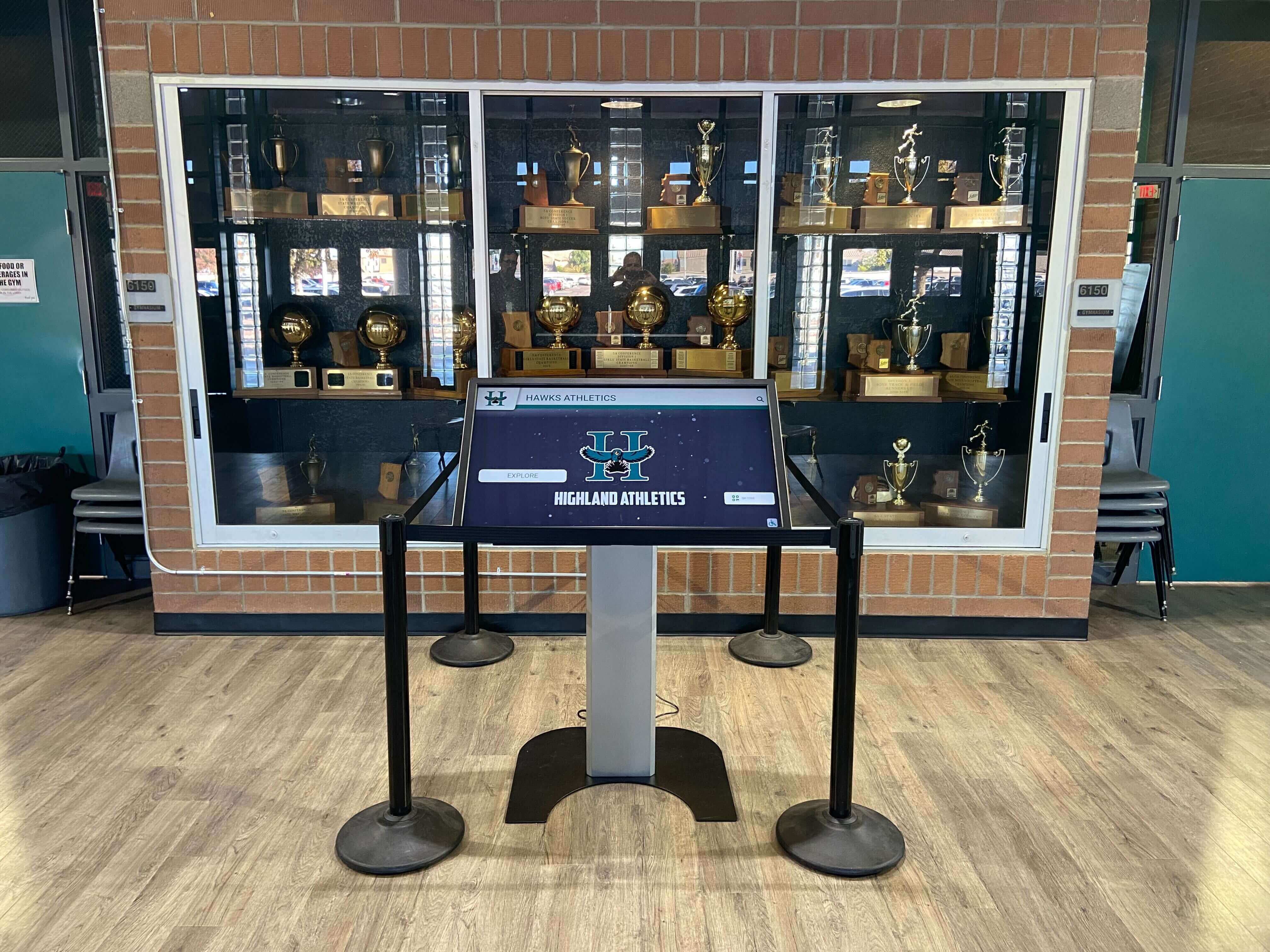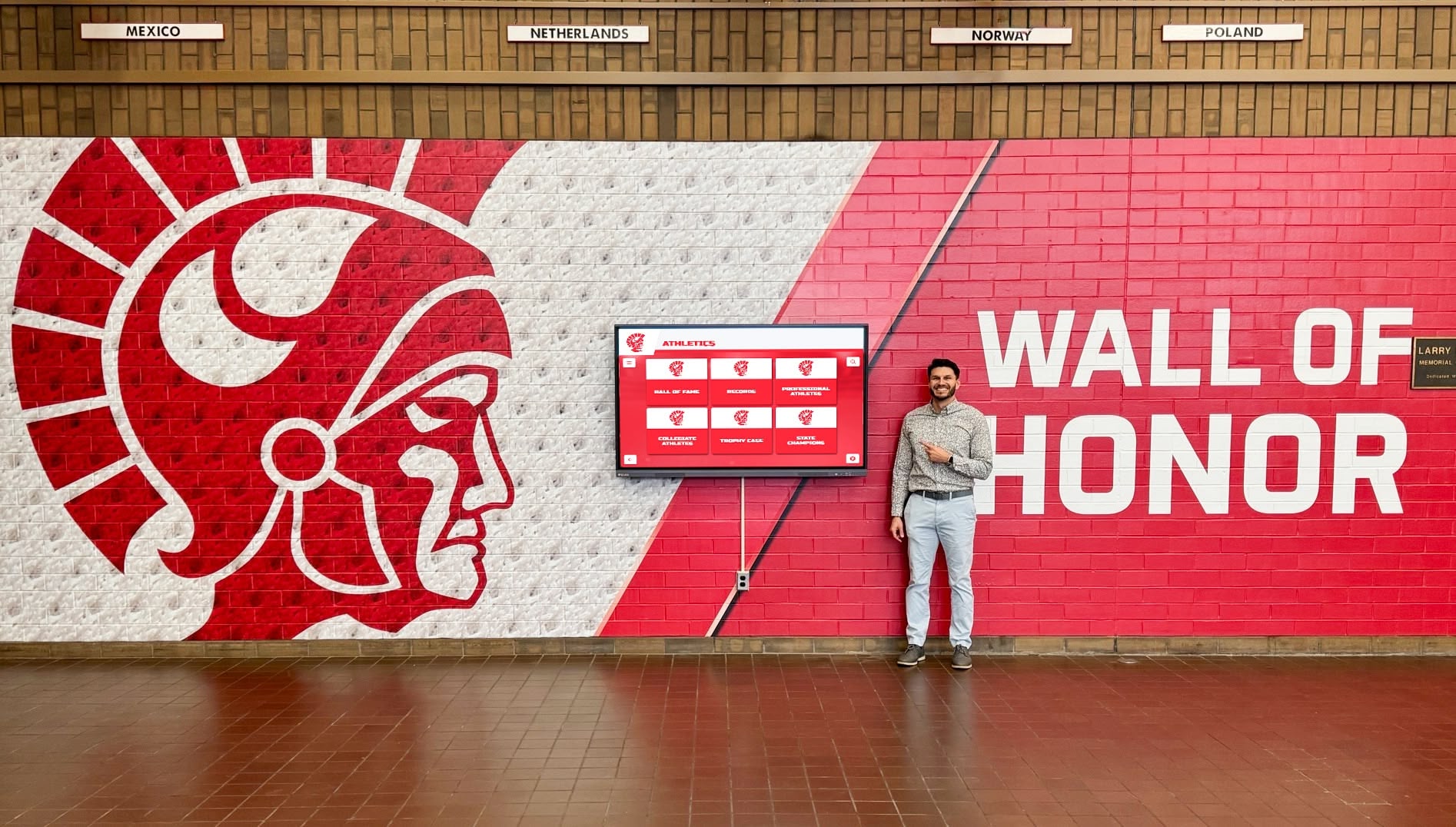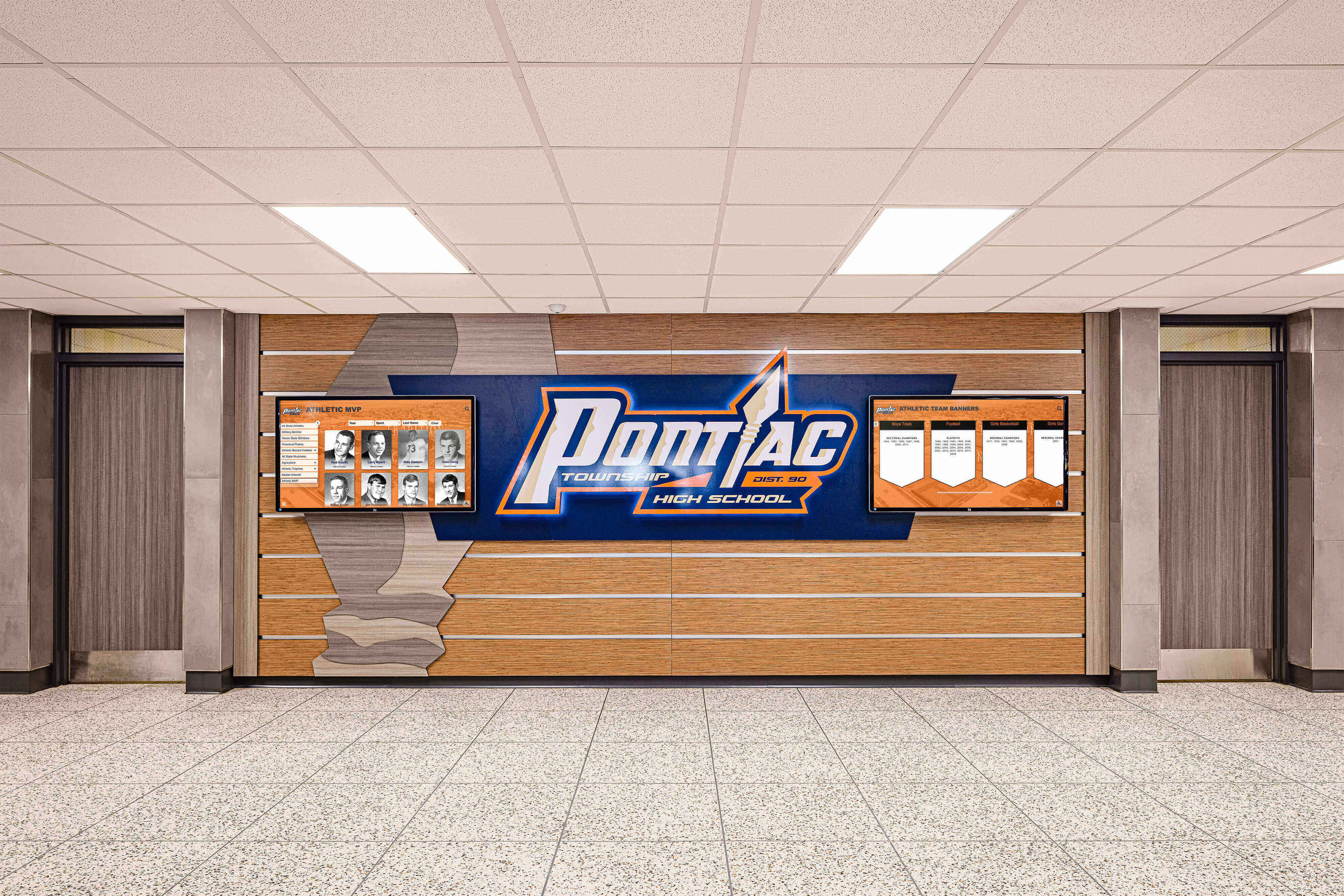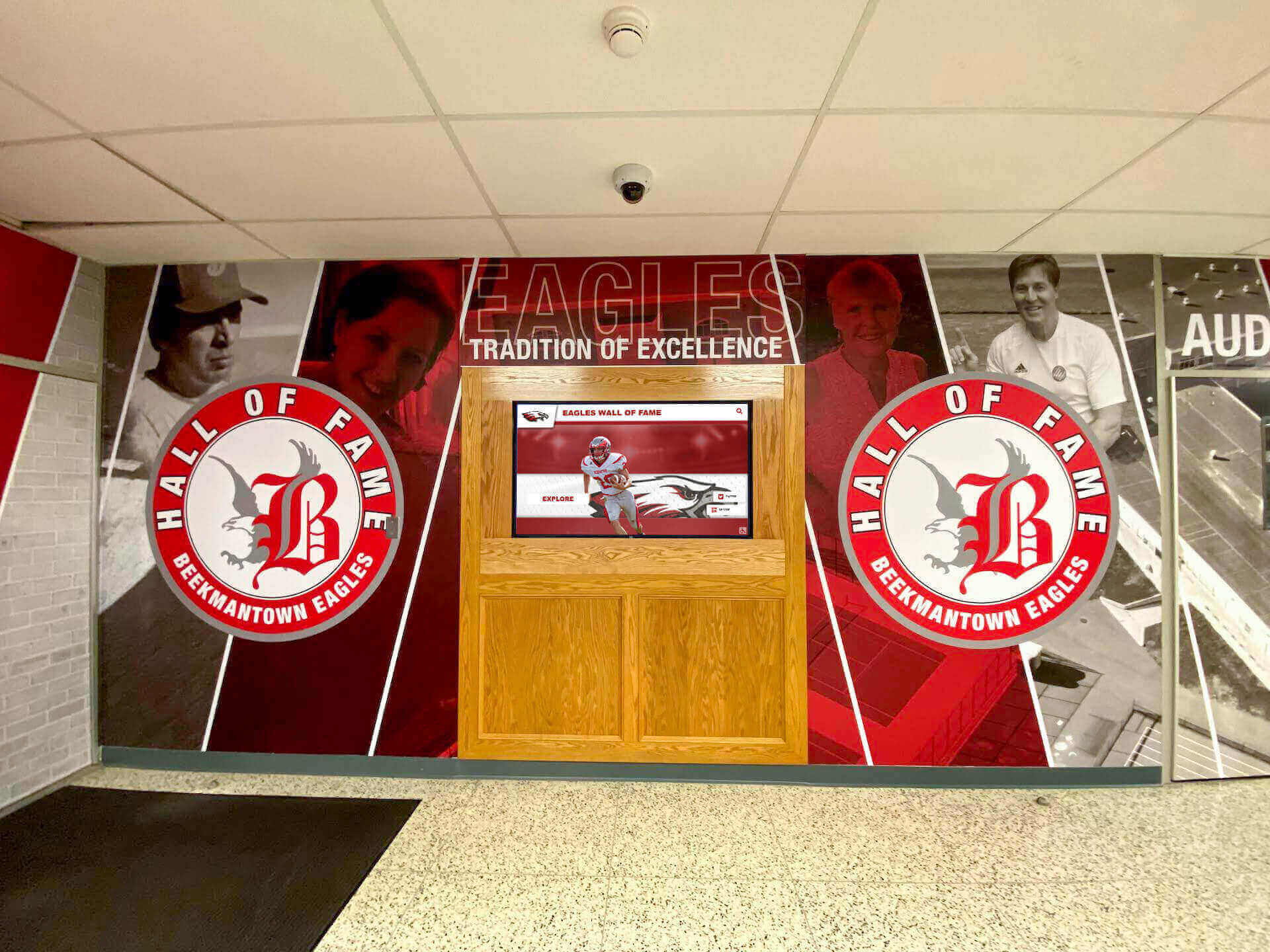School spirit and tradition represent the invisible threads connecting generations of students, staff, and community members to shared values, memorable experiences, and institutional identity. While these connections often live primarily in memory and stories passed down through years, Spirit & Tradition Walls transform intangible heritage into visible, permanent recognition that strengthens community bonds, inspires current students, and preserves institutional legacy for future generations.
Whether you’re an administrator seeking to strengthen school culture, a development professional recognizing that tradition drives alumni engagement, or a community member passionate about preserving institutional heritage, this comprehensive guide explores how Spirit & Tradition Walls celebrate what makes your school special while building the pride and connection that benefit entire communities.
Understanding Spirit & Tradition Walls: Purpose and Impact
Before designing recognition displays, understanding what Spirit & Tradition Walls accomplish helps ensure implementations serve strategic institutional objectives effectively.
Defining Elements of School Spirit and Tradition
Spirit and tradition encompass multiple interconnected dimensions that collectively create institutional identity and community culture.

Institutional Values and Mission
Every school possesses distinctive values and mission statements guiding educational philosophy, community expectations, and institutional priorities. Spirit & Tradition Walls make these abstract principles concrete through recognition of individuals exemplifying core values, documentation of programs reflecting mission priorities, historical examples demonstrating enduring commitment to founding principles, and visual representation of institutional character beyond simple slogans.
When values move from handbook pages to visible recognition displays, they become living principles that students encounter daily rather than abstract concepts mentioned occasionally during assemblies. This consistent visibility reinforces what the institution genuinely values, creating cultural expectations that shape student behavior and community standards.
Defining Moments and Milestones
Institutional histories contain transformative moments that fundamentally shaped what schools became—groundbreaking ceremonies launching facilities, championship victories establishing athletic traditions, academic achievements bringing national recognition, community crises overcome through collective effort, or leadership transitions marking new eras. These defining moments deserve permanent documentation preserving their significance across generations.
Spirit & Tradition Walls prevent institutional amnesia where significant moments fade from collective memory as people move on and time passes. New students, staff, and community members learn about defining moments that predated their arrival, connecting them to institutional narrative larger than their individual experience.
Annual Traditions and Rituals
Schools develop distinctive traditions repeated annually that create shared experiences, build anticipation, and provide continuity across changing student populations. These might include homecoming celebrations, rivalry game customs, spirit weeks, induction ceremonies, senior traditions, or community service days. While traditions exist primarily through active participation, Spirit & Tradition Walls document and celebrate these customs, ensuring knowledge passes systematically to new community members rather than through informal word-of-mouth that risks traditions being forgotten or diluted.

Community Character and Culture
Beyond specific events or formal values, schools develop distinctive character—the indefinable culture and personality making institutions unique. This character emerges from countless small interactions, shared experiences, inside jokes, local customs, and accumulated history creating sense of place. Spirit & Tradition Walls capture this cultural essence through photographs showing authentic community life, stories documenting memorable moments reflecting institutional personality, recognition of individuals embodying community character, and documentation of cultural evolution across decades.
Strategic Benefits of Spirit & Tradition Recognition
Institutions investing in comprehensive Spirit & Tradition Walls realize multiple strategic benefits justifying resource commitment.
Strengthened School Pride and Community Connection
Visible celebration of institutional uniqueness builds genuine pride among students, staff, alumni, and community members. When people see distinctive traditions, notable achievements, and institutional values prominently recognized, they develop stronger emotional connections to schools and increased identification with institutional identity.
According to research on school culture and student outcomes, students demonstrating strong school pride show higher attendance rates, increased academic engagement, greater participation in activities, and improved behavioral outcomes. Building school pride creates foundation for positive school culture benefiting all stakeholders through enhanced sense of belonging and shared purpose.
Enhanced Student Belonging and Identity Formation
Adolescence represents critical periods for identity development when young people seek belonging and form self-concepts that influence life trajectories. Schools where students feel genuine belonging and connection demonstrate dramatically better outcomes across academic, social, and emotional dimensions.
Spirit & Tradition Walls contribute to belonging by showing students they’re joining something meaningful with rich history, helping them understand institutional values and behavioral expectations, providing role models through recognition of notable alumni and past students, and creating shared knowledge and reference points building community cohesion.
When students see themselves as part of ongoing institutional story—temporary stewards of legacy passed from previous generations and responsibility to contribute positively for future students—they develop investment and pride that pure academic instruction cannot create alone.
Alumni Engagement and Institutional Loyalty
Alumni represent invaluable institutional resources providing financial support, volunteer service, professional networks, and ongoing engagement. The emotional connections driving alumni loyalty often trace directly to school experiences, traditions participated in, and sense that institutions shaped who they became.
Spirit & Tradition Walls strengthen these connections by honoring alumni achievements and contributions, documenting traditions alumni remember fondly, providing tangible links to school experiences years later, and demonstrating that institutions value and remember past community members. These recognition elements create reciprocal relationships where alumni feel valued and connected, increasing likelihood they’ll support institutions through giving and engagement.
Effective alumni recognition strategies transform casual graduates into lifelong supporters invested in institutional success and willing to contribute time, resources, and influence advancing school missions.
Recruitment and Competitive Differentiation
Families choosing schools evaluate multiple factors including academic quality, extracurricular opportunities, facilities, and cultural fit. In competitive educational markets where multiple schools offer similar academic programs, institutional culture and distinctive identity often become deciding factors.
Comprehensive Spirit & Tradition Walls demonstrate institutional stability and longevity, showcase vibrant community culture and student experience, communicate clear values and educational philosophy, and create memorable distinctive impressions differentiating schools from competitors with minimal cultural identity visibility.
Prospective families touring facilities and encountering well-designed Spirit & Tradition Walls develop tangible understanding of school culture that abstract descriptions cannot convey, influencing enrollment decisions in competitive situations.
Content Categories for Spirit & Tradition Walls
Effective Spirit & Tradition Walls balance multiple content categories collectively documenting institutional identity comprehensively.
Founding History and Institutional Evolution
Understanding institutional origins and evolution helps current community members appreciate how schools developed distinctive characters and reached present forms.

Founding Principles and Early History
Documentation of founding circumstances, original mission, early leadership, and initial student populations provides historical context showing institutional roots. Many schools possess compelling founding stories—community determination to establish local education, religious mission driving school creation, philanthropic vision bringing institutions into existence, or educational innovation motivating alternative school models.
These founding narratives deserve prominent recognition through historical photographs showing early facilities and student life, founder biographies documenting vision and leadership, original mission statements demonstrating enduring values, and founding documents providing primary source connections to origins.
Milestone Timeline Documentation
Institutional timelines trace evolution through decades showing facility expansions, program additions, leadership transitions, accreditation achievements, and other significant milestones that shaped development. These timelines help community members understand how institutions grew from modest beginnings to current forms, providing perspective on change while identifying enduring elements that persisted across eras.
Interactive digital timeline displays enable comprehensive historical documentation that static displays cannot accommodate due to space limitations, allowing detailed exploration of multiple decades without overwhelming viewers with excessive simultaneous information.
Notable Alumni and Distinguished Graduates
Alumni achievements reflect institutional impact extending beyond graduation ceremonies. Recognition of distinguished graduates who achieved professional success, demonstrated exceptional character, contributed significantly to communities, or exemplified institutional values provides current students with aspirational examples showing education’s long-term benefits.
Comprehensive alumni recognition programs balance recent and historical graduates, represent diverse achievement types beyond narrow definitions of success, and include sufficient biographical detail that recognition becomes meaningful rather than simple name lists lacking context.
Traditional Events and Annual Celebrations
Annual traditions create shared experiences binding communities across changing student populations and staff transitions.
Homecoming and Spirit Week Traditions
Homecoming celebrations and spirit weeks represent high-visibility traditions generating school-wide participation and creating memorable moments that alumni remember decades later. Spirit & Tradition Walls preserve these experiences through documentation of annual themes and activities, photography capturing participation and excitement, recognition of spirit week champions and creative participants, and historical comparison showing tradition evolution over time.
This documentation ensures traditions remain vital and understood across generations rather than being diluted through inconsistent implementation or forgotten during leadership transitions when institutional memory holders leave.
Athletic Traditions and Rivalry Customs
Athletic programs generate distinctive traditions including pre-game rituals, rivalry week customs, championship celebration protocols, and retired number honorees. These traditions create program identity and competitive culture that recruits seek and current athletes value deeply.
Recognition might include rivalry game history and traveling trophy documentation, traditional chants, cheers, and fight song preservation, athletic hall of fame inductees and record holders, and documentation of signature victories and championship moments defining program identity.
Academic and Arts Traditions
Beyond athletics, academic competitions, arts performances, and scholarly traditions deserve equal recognition demonstrating that institutional tradition encompasses intellectual and creative excellence. This might include academic olympiad participation and achievement documentation, signature performing arts events and productions, science fair traditions and notable projects, and literary or artistic competitions where students have excelled.
Comprehensive recognition across academic, athletic, and artistic domains demonstrates that tradition encompasses all excellence forms rather than privileging narrow achievement categories.
Community Values and Character Education
Schools serve not only academic functions but also character development and civic education preparing students for meaningful community participation.

Service Learning and Community Contribution
Community service initiatives teach students responsibility beyond self-interest while building connections to broader communities. Spirit & Tradition Walls recognize this important dimension through documentation of signature service projects and community partnerships, recognition of students accumulating significant volunteer hours, stories showing service impact on individuals and communities, and long-term tracking demonstrating sustained institutional commitment to service values.
This recognition communicates that institutions value contribution and character alongside academic and competitive achievement, shaping student understanding about what excellence encompasses beyond test scores and trophies.
Character Awards and Citizenship Recognition
Many schools implement character recognition programs acknowledging students demonstrating integrity, kindness, perseverance, leadership, or other valued qualities. These character-based awards deserve prominent inclusion in Spirit & Tradition Walls showing that institutional values extend beyond measurable achievements to human qualities that define community culture.
Recognition might include documented examples of extraordinary character demonstration, student testimonials explaining how award recipients impacted peers, teacher reflections on character traits that make students special, and tracking showing character emphasis remains constant priority across decades.
Diversity, Equity, and Inclusion Initiatives
Modern schools increasingly prioritize inclusive communities where all students feel valued regardless of backgrounds, identities, or circumstances. Spirit & Tradition Walls can document this commitment through recognition of cultural heritage months and celebrations, diversity leadership and student organization accomplishments, historical milestones in institutional inclusion evolution, and stories demonstrating how diversity strengthens community culture.
This recognition demonstrates that tradition isn’t only about preserving past but also about evolving to reflect changing understanding about creating communities where everyone truly belongs.
Traditional vs. Modern Spirit & Tradition Wall Approaches
Schools implement Spirit & Tradition recognition through various formats ranging from traditional physical displays to comprehensive digital interactive systems.
Physical Displays: Benefits and Limitations
Traditional approaches using photographs, plaques, display cases, and wall graphics have served schools for generations and remain widely implemented.
Wall-Mounted Photo Collages and Displays
Many schools create tradition walls through curated photograph collections showing historical moments, annual events, student life across decades, and memorable experiences. When professionally designed and maintained, these photo walls create impressive visual impact and tangible connection to institutional history that particularly resonates with older generations valuing physical displays.
However, physical photo displays face significant limitations including finite wall space eventually filling completely, fading and deterioration requiring periodic replacement, static content that can’t easily be updated or rotated, and limited information beyond what brief captions can convey.
Trophy Cases and Memorabilia Collections
Physical artifacts—championship trophies, historical jerseys, vintage yearbooks, original documents—provide tangible connections to tradition that photographs cannot fully replicate. Well-curated memorabilia displays create museum-quality presentations honoring institutional heritage appropriately.
Yet trophy case limitations prove substantial as collections grow beyond available display space, security concerns complicate access and handling, environmental conditions affect long-term preservation, and static displays offer minimal engagement beyond brief viewing during passing.
Painted Murals and Permanent Installations
Some institutions commission murals, mosaics, or permanent artistic installations celebrating traditions and institutional identity. These permanent fixtures become beloved community landmarks and source of pride while creating distinctive visual environments.
The permanence constituting their appeal also represents limitation—updating content requires expensive repainting or reconstruction, content selected becomes fixed for decades regardless of changing priorities, and space occupied cannot serve other recognition needs as institutional focus evolves.
Digital Interactive Spirit & Tradition Displays
Modern digital recognition platforms address traditional display limitations while adding powerful capabilities enhancing preservation, engagement, and strategic value.

Unlimited Content Capacity
Digital systems provide essentially unlimited recognition capacity accommodating comprehensive historical documentation without space constraints. Every significant tradition, achievement, and milestone receives appropriate coverage rather than competing for limited physical space. This unlimited capacity fundamentally changes recognition philosophy from selective editing to comprehensive preservation.
Schools can document complete institutional histories, recognize all deserving individuals and achievements, preserve extensive multimedia content including videos and audio, and continue adding recognition indefinitely without facility modifications or space additions.
Multimedia Storytelling and Rich Content
Digital platforms support content types impossible with physical displays including high-definition video documenting traditions and memorable events, audio recordings preserving voices, songs, and oral histories, comprehensive photo galleries showing multiple perspectives and moments, detailed narratives providing context and significance, and interactive timelines enabling historical exploration across decades.
This multimedia richness brings tradition to life in ways that static plaques and photographs cannot match, creating engaging experiences that hold attention and build emotional connections through storytelling depth.
Dynamic Updates and Seasonal Content Rotation
Cloud-based content management enables instant updates as events occur, seasonal content rotation emphasizing current activities and traditions, scheduled automatic changes without manual intervention, and remote management from any internet-connected device without physical display access.
This flexibility ensures content remains perpetually current and relevant rather than becoming outdated between infrequent update cycles that characterize physical displays requiring professional services for modification.
Interactive Exploration and Search Capabilities
Touchscreen interfaces transform passive viewing into active exploration through searchable databases allowing visitors to find specific people or events quickly, filtering by time period, tradition type, or other categories, related content suggestions connecting associated achievements and moments, and user-controlled navigation letting visitors explore content matching their interests rather than viewing only curator-selected highlights.
This interactivity particularly engages younger generations accustomed to digital interfaces and active information exploration rather than passive content consumption.
Analytics and Engagement Measurement
Modern digital platforms provide usage analytics showing which content generates most interest, common search queries revealing visitor priorities, interaction duration indicating engagement depth, and demographic insights about who accesses content and when.
These metrics help administrators understand recognition impact, refine content strategies based on evidence about what resonates, and demonstrate measurable value justifying continued investment in recognition programs.
Hybrid Approaches Combining Physical and Digital Elements
Many institutions find that combining traditional and modern elements creates the most effective Spirit & Tradition recognition serving diverse preferences and maximizing impact.
Signature Physical Displays with Digital Depth
Hybrid implementations might feature prominent physical displays in main entrances showing signature traditions and achievements, complemented by nearby digital displays providing comprehensive historical documentation, detailed stories and multimedia content, and searchable access to complete recognition database.
This combination preserves tangible physical presence that many stakeholders value while addressing limitations through digital augmentation that provides depth, searchability, and unlimited capacity that physical displays cannot offer.
Traditional Spaces Enhanced with Interactive Technology
Some schools maintain traditional recognition spaces—perhaps trophy rooms or heritage halls—but enhance them with digital elements including digital directory kiosks helping visitors navigate physical displays, QR codes linking physical artifacts to online multimedia content, interactive timelines providing historical context for displayed items, and virtual extensions allowing remote access to physical collection content.
These enhancements extend physical display value without abandoning traditional formats that communities may value for historical or sentimental reasons.
Implementing Effective Spirit & Tradition Walls
Successful implementations follow systematic approaches addressing planning, content development, technology selection, and ongoing management.
Planning Phase: Defining Scope and Priorities
Begin with comprehensive planning ensuring Spirit & Tradition Walls reflect institutional priorities and serve strategic objectives effectively.
Stakeholder Engagement and Input
Involve diverse constituencies in planning processes including administrators articulating institutional priorities and values, students providing current perspective on meaningful traditions, alumni sharing historical knowledge and tradition memories, teachers offering insights about educational culture and student experience, and community members contributing local context and institutional relationships.
This broad engagement builds support, surfaces concerns before they become obstacles, and ensures implementations reflect diverse perspectives rather than narrow administrative viewpoints.
Content Inventory and Gap Analysis
Document existing recognition efforts identifying what’s already preserved and what gaps exist including comprehensive tradition inventory listing annual events and customs, historical materials assessment evaluating available documentation, achievement documentation reviewing what’s currently recognized versus what deserves attention, and value alignment checking whether recognition reflects stated institutional priorities or contradicts them through omission or emphasis.
This inventory reveals opportunities where Spirit & Tradition Walls can add most value while preventing duplication of existing recognition receiving adequate attention through other channels.
Resource Assessment and Budget Planning
Establish realistic resource parameters including available budget for initial implementation and ongoing operation, staff capacity for content development and system management, physical space allocation for displays, and timeline expectations balancing completeness with reasonable launch dates.
Clear resource understanding prevents ambitious plans that exceed capacity leading to incomplete implementations or unsustainable commitments that deteriorate after initial enthusiasm fades.
Content Development: Research and Documentation
Quality content determines Spirit & Tradition Wall effectiveness regardless of display format or technology sophistication.

Historical Research and Information Gathering
Comprehensive Spirit & Tradition recognition requires systematic research gathering information from distributed sources including yearbook archives documenting student life and activities across decades, school newspaper collections providing contemporary accounts of events, administrative records containing official documentation, community newspapers covering school activities and achievements, and oral history interviews with long-time community members, retired staff, and alumni possessing detailed knowledge about traditions and institutional evolution.
This research proves time-intensive but essential for comprehensive historical coverage that doesn’t privilege recent history simply because information remains easily accessible while older traditions risk being forgotten.
Photography and Visual Asset Collection
Compelling visual content proves essential for engaging Spirit & Tradition displays. Systematic collection should include historical photograph scanning and preservation, current event documentation through assigned photographers, student life photography capturing authentic daily experiences, facility and campus documentation showing environmental evolution, and memorabilia digitization preserving vulnerable physical items.
Establishing photography standards ensures consistent professional quality across all content including resolution requirements for digital display, composition and lighting guidelines, subject identification protocols, and organized storage systems enabling efficient retrieval.
Story Collection and Narrative Development
Beyond photographs and basic facts, compelling narratives bring tradition to life through personal stories and contextual understanding including first-person accounts from tradition participants, significance explanations helping audiences understand why moments mattered, tradition origin stories documenting how customs began, and evolution documentation showing how traditions adapted across decades while maintaining core identity.
These narratives transform recognition from dry historical documentation into engaging storytelling that builds emotional connections and helps audiences understand tradition’s human dimensions.
Technology Selection and Implementation
Schools implementing digital Spirit & Tradition Walls face technology decisions significantly impacting user experience, operational complexity, and long-term satisfaction.
Display Hardware Considerations
Hardware selection should address screen size appropriate for viewing distance and location, touch technology balancing responsiveness and durability, mounting approach based on space constraints and accessibility requirements, and commercial-grade components rated for continuous public use rather than consumer electronics lacking reliability for institutional applications.
Professional installation ensures proper mounting, cable management, power provision, and network connectivity supporting reliable long-term operation.
Software Platform Requirements
Purpose-built recognition platforms designed specifically for educational institutions offer significant advantages over generic digital signage systems including pre-designed templates optimized for tradition and achievement content, intuitive content management requiring no technical expertise, built-in search and navigation features, mobile-responsive designs working across displays and personal devices, and ongoing platform improvements without additional development costs.
Solutions like Rocket Alumni Solutions provide comprehensive platforms specifically designed for school recognition rather than generic systems requiring extensive customization for effective tradition documentation.
Content Management Workflows
Sustainable implementations establish clear workflows for content development, review, approval, and publication including role assignments defining who creates, reviews, and approves content, quality standards ensuring professional consistency, approval processes balancing content quality with timely publication, and update schedules preventing recognition from becoming outdated through neglect.
Documented workflows survive staff transitions ensuring recognition continuity across personnel changes that might otherwise disrupt operations when key individuals leave institutions.
Measuring Impact and Ensuring Sustainability
Effective Spirit & Tradition Walls require assessment and continuous improvement based on evidence about what works in your specific context.
Assessing Recognition Effectiveness
Understanding whether Spirit & Tradition Walls achieve intended outcomes guides resource allocation and improvement priorities.
Engagement Metrics and Analytics
Digital platforms provide quantitative data tracking recognition usage including visitor interaction frequency and duration, content popularity revealing which traditions resonate most, search patterns showing what information visitors seek, and sharing behavior indicating which content generates social amplification.
These metrics provide objective evidence about engagement complementing subjective impressions and anecdotal feedback.
Stakeholder Feedback and Qualitative Assessment
Beyond usage metrics, qualitative feedback reveals whether recognition serves intended purposes including student surveys measuring tradition awareness and school pride, alumni perspectives on recognition quality and emotional impact, parent and community input about cultural understanding, and staff observations about student engagement and tradition participation.
Regular feedback collection creates improvement opportunities while demonstrating that institutions value stakeholder perspectives about recognition effectiveness.
Strategic Outcome Connections
The most sophisticated assessment connects Spirit & Tradition recognition to broader institutional outcomes including school pride and belonging indicators, alumni engagement and giving metrics, enrollment trends in competitive markets, and student achievement and behavior outcomes potentially influenced by cultural factors.
While isolating recognition’s specific contribution proves methodologically challenging, tracking whether investments in tradition celebration correlate with desired outcomes helps justify continued resource commitment.
Ensuring Long-Term Sustainability
One-time implementations rarely create lasting impact. Sustainable Spirit & Tradition recognition requires systematic approaches embedded in ongoing operations.
Maintenance and Update Systems
Establish regular maintenance schedules including technology system monitoring and updates, content review ensuring accuracy and currency, physical display maintenance where applicable, and security monitoring protecting systems and content.
Documented maintenance procedures prevent recognition from deteriorating through neglect when attention shifts to other priorities during busy periods.
Content Development Pipeline
Sustainable programs create systematic content development including event documentation protocols capturing traditions as they occur, historical project initiatives gradually expanding backward historical coverage, alumni contribution processes enabling community participation in documentation, and seasonal update cycles ensuring timely recognition of annual traditions.
This systematic approach prevents reliance on individual enthusiasm that may wane or disappear when key champions move to other roles or institutions.
Resource Allocation and Institutional Support
Long-term success requires ongoing resource commitment including dedicated budget for technology maintenance and improvements, staff time allocation for content development and management, technology support ensuring reliable operation, and administrative priority demonstrating that tradition recognition matters institutionally.
Without sustained resources, initial investments gradually lose value as content becomes outdated, technology fails without maintenance, and displays fall into disrepair undermining their intended positive impact.
Conclusion: Preserving Heritage, Building Pride, Inspiring Future
Spirit & Tradition Walls transform abstract institutional culture into visible, permanent recognition that strengthens community bonds, preserves invaluable heritage, and inspires current students through tangible connection to institutional legacy. These displays serve far more than nostalgic purposes—they function as strategic assets building school pride, enhancing student belonging, strengthening alumni engagement, and communicating distinctive institutional identity that differentiates schools in competitive educational markets.
The evolution from static photograph collages and limited trophy cases to comprehensive digital recognition systems with unlimited capacity, multimedia storytelling, interactive exploration, and engagement analytics dramatically expands what’s possible in tradition celebration. Modern platforms enable institutions to document complete histories rather than selective highlights, tell compelling stories through video and audio rather than just text and photos, update recognition instantly rather than waiting months for physical display modifications, and demonstrate measurable impact through analytics that traditional approaches cannot provide.
Whether implementing recognition programs from scratch, enhancing existing traditional displays that no longer serve institutional needs effectively, or modernizing outdated systems with contemporary capabilities, the opportunity exists to create Spirit & Tradition Walls that genuinely serve your community through meaningful celebration of what makes your institution special across generations.
Ready to transform how your school celebrates spirit and tradition? Rocket Alumni Solutions provides purpose-built platforms specifically designed for educational recognition, combining unlimited capacity for comprehensive tradition documentation, intuitive management enabling non-technical staff to update content easily, proven reliability across hundreds of school implementations, and features addressing unique needs that generic alternatives cannot match. Honor your heritage, strengthen your community, and inspire your future through recognition that truly matters.




































